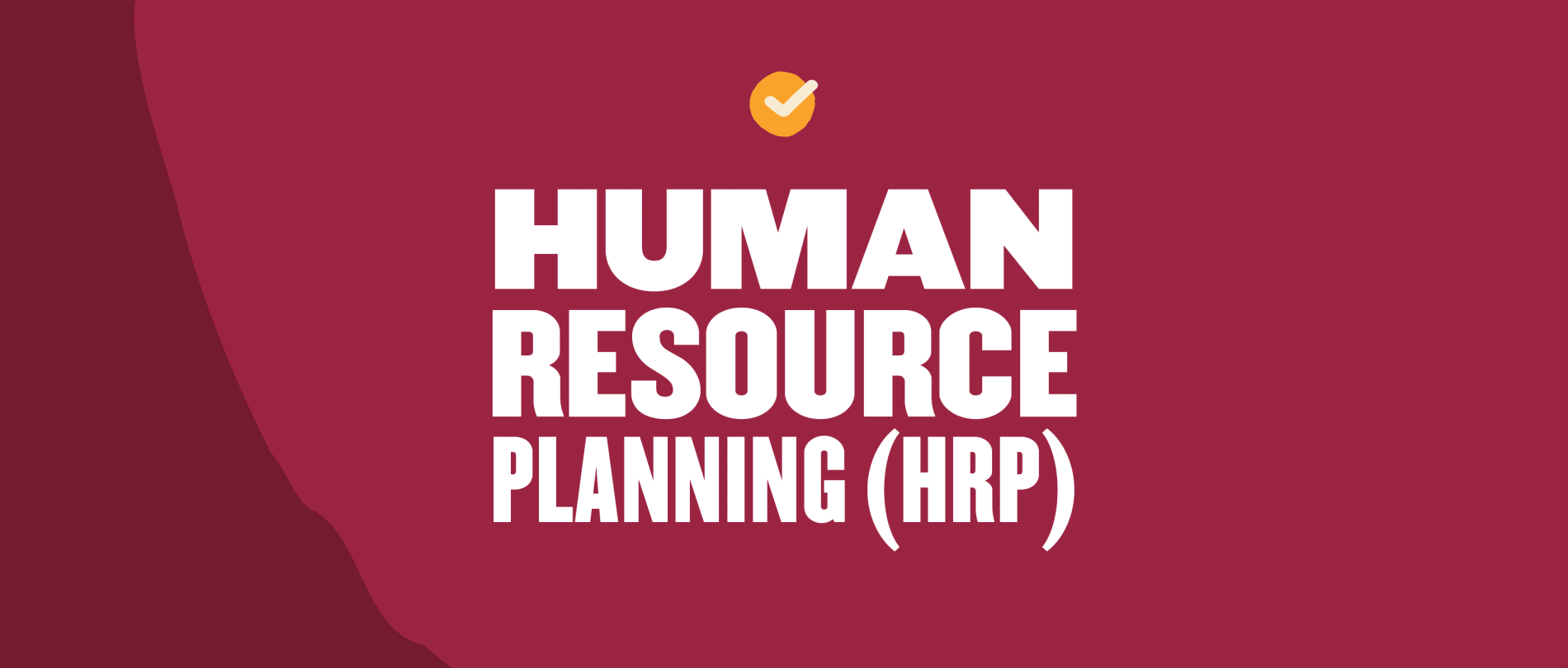The world of business is constantly changing. But one thing remains the same—the importance of human resources. After all, an organization’s success largely depends on the people behind it.
But to harness the full potential of your workforce, you need a strategic approach.
That’s where human resource planning (HRP) comes into play.
In this blog post, we take a deeper look into what HRP means and why it’s so important to your organization’s HR strategy. We’ll also share a step-by-step walkthrough for you to effectively carry out your own HRP, as well as some commonly used tools to help you improve your HRP processes from the get-go.
What is human resource planning (HRP)?
Human resource planning (HRP) is the systematic forecasting of an organization’s future HR requirements.
Ultimately, it’s to make sure the right people with the right skills are in the right places at the right times.
It’s an ongoing, data-driven process to optimize a company’s most valuable asset—its people—by avoiding shortages or surpluses.
This involves identifying current and future hiring or training and development needs, addressing skill gaps, and implementing strategies for talent acquisition.
HRP is about aligning HR strategies with the evolving needs of your business to ensure optimal performance and productivity while avoiding costly workforce imbalances.
What is the goal of HR planning?
The ultimate goal of HRP is to maintain an optimal workforce size that maximizes the company’s profitability.
As a result, one of the main aims of HRP is to secure the right quantity and quality of employees that an organization needs to meet its objectives. This requires HR leaders to focus not just on recruitment but also on development, retention, and workforce optimization.
Today, more and more people are working remotely due to increasing globalization and more flexible working practices. In this case, HRP helps HR managers adopt new recruitment, training, and employee retention methods and tools, ensuring they can assess the entire workforce, no matter where they are in the world.
As well as location, HRP is also there to ensure that the right talent is strategically placed across various departments, fostering agility and adaptability.
Why are human resource planning processes important?
HRP is not just a concept—it’s a catalyst for productivity and profitability. An HR planning process empowers businesses to attract and retain the right talent, equipped with both the technical and soft skills to perform best in their roles.
HRP is crucial for multiple reasons:
- Enhances employee value. HRP means assessing existing employees, their skills, and training needs, and seeing how they can upskill. This enables businesses to save on recruitment costs while also fostering employee growth and loyalty.
- Helps organizations adapt to industry shifts. Through HRP, organizations can anticipate changes in talent needs and industry dynamics. This strategic foresight allows businesses to manage agile role transitions and budget for new positions, especially when identifying niche markets.
- Keeps a competitive edge. HRP empowers companies to make informed hiring and training decisions, aligning with employee preferences, work-life balance, and other attractive job factors.
- Aids long-term growth. HR professionals use HRP to forecast hiring needs, department expansions, and potential retirements. This forward-thinking approach aids in budgeting for future hiring requirements, making sure the right balance in the optimal number of people in the workforce is achieved.
In short, a human resource planning process acts as a compass, guiding organizations through the ebb and flow of industry changes, promoting cost control, and driving workforce efficiency, making it essential for securing a competitive edge.
As a result, HRP is vital to organizations, serving as the linchpin of strategic human resource management, and helping HR managers achieve several objectives:
- Anticipate cultural shifts and business evolutions
- Identify changing job and skill requirements
- Hire promptly for organizational changes
- Tailor hiring practices and benefits
- Foster workforce skill enhancement
- Nurture employee career paths
- Maintain effective HR processes
- Optimize HR budget allocation
What are the challenges of HR planning?
It’s clear that HRP offers plenty of advantages. But it still comes with several challenges for organizations to navigate.
Common obstacles could include anything from the unpredictable nature of future events to the difficulty of forecasting employee turnover, and even managing factors like illness, promotions, vacations, or position changes.
To tackle these issues, successful HRP needs to be adaptable, and managers also need to continuously monitor performance for any changes.
When forming their HR plan checklist, HR managers need to strategize how to:
- Attract, hire, and retain skilled employees
- Select, train, and reward the best people
- Manage absences and conflicts
- Carry out promotions or layoffs
It’s crucial to recognize potential challenges in the HRP process, including:
- Time and effort required
- Financial investment
- Imperfect forecasting
- Inevitable market changes
- Technology and data requirements, such as integrating data from different sources
- Pushback on internal changes from employees
By acknowledging these challenges, HR managers can better prepare to address them, ultimately boosting their HRP efforts.
Recommended For Further Reading
What are the steps of HR planning?
HRP is a structured process that usually includes five key steps for HR managers to follow. Let’s take a look at these steps of HRP more closely:
- Analyze the current workforce. Before carrying out HRP, assess your current employees and their attributes, skills, and how they align with your business goals. Factors like the total number of people, their departments, job titles, and performance data give more insight into your existing capabilities.
- Forecast changes. This step is a little trickier. But with data on current employees to hand, you can predict future workforce requirements. For example, this workforce planning might include supply forecasting—checking whether your current workforce can meet business demands—and demand forecasting—choosing the types and quantity of employees needed to match your future business goals.
- Carry out gap analysis. After forecasting, the next step is gap analysis. This involves comparing your current workforce quantity and skill levels against what’s necessary to meet your organizational goals. For instance, recognizing current workforce status, defining your ideal future status, and spotting the gaps that need to be filled.
- Develop your HR plan. Armed with insights from the previous steps, you can now put together your strategic HR plan. Align your plan with the organization’s overall strategy, and include talent strategies that bridge the supply-demand gap. You may want to include specific strategies for recruitment, training, benefits, performance management, remote work, and company culture.
- Monitor, review, and replan. Implementing your plan is only half the battle. Now comes the most important part—monitoring and reviewing your HR plan to make sure it’s effective. Ask for feedback from the team via performance reviews or surveys to spot obstacles and areas for improvement. For now, make sure your plan can stay adaptable to meet your business needs.
Remember—HRP is not a one-time event, but an ongoing activity to ensure your company stays agile and prepared for the future.
What tools are used for HR planning?
So, we’ve already said that you should be continually collecting and analyzing data as part of your HRP. But how?
Here are some of our favorite effective tools to aid you in your HRP processes:
- Surveys. Gather data on specific HR topics, such as managers’ opinions on employee skills and productivity, people’s training preferences, satisfaction with benefits and compensation programs, workplace culture, and employee happiness. Use these to identify opportunities like internal promotions, or potential weaknesses that may lead to high turnover or reduced productivity.
- HR dashboards. Collect and display data to provide an overall view of HR metrics and aid you in your planning process, such as turnover rates, satisfaction levels, productivity, skill levels, and internal promotions.
- Performance management systems. Provide feedback on employee performance and deliver performance ratings over time. This is critical during the integration phase of HRP so that HR professionals can see the success of role changes and additional training.
- Human capital management systems (HCMs). Combine various HR processes, from planning and payroll management to compensation, hiring, onboarding, recruitment, turnover rate analysis, and productivity measurement. These processes are automated to aid adjustments in HR planning and performance measurement.
- Compensation and benefits software. Easily compare current pay scales and benefits against economic trends and industry standards. It helps to ensure that people receive competitive compensation and benefits, leading to reduced turnover, enhanced satisfaction, and improved productivity.
HRP ensures that you have the right people in the right places to drive your business forward. By understanding the meaning, goals, importance, challenges, steps, and tools of HR planning, you can make more informed decisions and steer your organization toward greater success.


